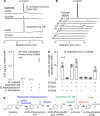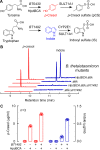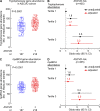Microbe-derived uremic solutes enhance thrombosis potential in the host
- PMID: 37947418
- PMCID: PMC10746243
- DOI: 10.1128/mbio.01331-23
Microbe-derived uremic solutes enhance thrombosis potential in the host
Abstract
Alterations in gut microbial composition and function have been linked to numerous diseases. Identifying microbial pathways responsible for producing molecules that adversely impact the host is an important first step in the development of therapeutic interventions. Here, we first use large-scale clinical observations to link blood levels of defined microbial products to cardiovascular disease risks. Notably, the previously identified uremic toxins p-cresol sulfate and indoxyl sulfate were shown to predict 5-year mortality risks. After identifying the microbes and microbial enzymes involved in the generation of these uremic toxins, we used bioengineering technologies coupled with colonization of germ-free mice to show that the gut microbial genes that generate p-cresol and indole are sufficient to confer p-cresol sulfate and indoxyl sulfate formation, and a pro-thrombotic phenotype in vivo. The findings and tools developed serve as a critical step in both the study and targeting of these gut microbial pathways in vivo.
Keywords: cardiovascular disease; gut microbes; indoxyl sulfate; mortality; p-cresol sulfate; uremic toxins.
Conflict of interest statement
S.L.H. reports being named as co-inventor on pending and issued patents held by the Cleveland Clinic relating to cardiovascular diagnostics and therapeutics, being a paid consultant formerly for Procter & Gamble in the past, and currently being with Zehna Therapeutics. He also reports having received research funds from Procter & Gamble and Zehna Therapeutics and being eligible to receive royalty payments for inventions or discoveries related to cardiovascular diagnostics or therapeutics from Procter & Gamble, Zehna Therapeutics, and Cleveland HeartLab, a wholly owned subsidiary of Quest Diagnostics. M.A.F. is a co-founder and director of Federation Bio and Kelonia and a co-founder of Revolution Medicines. M.A.F. also reports the following: Ownership Interest: Kelonia, NGM Bio; Patents or Royalties: Federation Bio; and Advisory or Leadership Role: Federation Bio, Kelonia, NGM Bio, The Column Group, and Chan Zuckerberg Science. W.H.W.T. reports being a consultant for Sequana Medical A.G., Owkin Inc., Relypsa Inc., and PreCardiac Inc., having received honorarium from Springer Nature for authorship/editorship, and American Board of Internal Medicine for exam writing committee participation—all unrelated to the subject and contents of this paper. The other authors have reported that they have no relationships relevant to the contents of this paper to disclose.
Figures







Comment in
-
Can our microbiome break our hearts? Collaborative production of p-cresol sulfate and indoxyl sulfate by commensal microbes increases susceptibility to thrombosis.mBio. 2024 Feb 14;15(2):e0269223. doi: 10.1128/mbio.02692-23. Epub 2024 Jan 16. mBio. 2024. PMID: 38226819 Free PMC article.
References
-
- Chiang C-E, Schwartz GG, Elbez Y, Szarek M, Bhatt DL, Bittner VA, Diaz R, Erglis A, Goodman SG, Hagström E, Jukema JW, Liberopoulos E, Loy M, Pordy R, White HD, Simon T, Steg PG, ODYSSEY OUTCOMES Investigators . 2022. Alirocumab and cardiovascular outcomes in patients with previous myocardial infarction: prespecified subanalysis from ODYSSEY OUTCOMES. Can J Cardiol 38:1542–1549. doi:10.1016/j.cjca.2022.05.021 - DOI - PubMed
-
- Cholesterol Treatment Trialists C, Baigent C, Blackwell L, Emberson J, Holland LE, Reith C, Bhala N, Peto R, Barnes EH, Keech A, Simes J, Collins R. 2010. Efficacy and safety of more intensive lowering of LDL cholesterol: a meta-analysis of data from 170,000 participants in 26 randomised trials. Lancet 376:1670–1681. doi:10.1016/S0140-6736(10)61350-5 - DOI - PMC - PubMed
-
- Cannon CP, Blazing MA, Giugliano RP, McCagg A, White JA, Theroux P, Darius H, Lewis BS, Ophuis TO, Jukema JW, De Ferrari GM, Ruzyllo W, De Lucca P, Im K, Bohula EA, Reist C, Wiviott SD, Tershakovec AM, Musliner TA, Braunwald E, Califf RM, IMPROVE-IT Investigators . 2015. Ezetimibe added to statin therapy after acute coronary syndromes. N Engl J Med 372:2387–2397. doi:10.1056/NEJMoa1410489 - DOI - PubMed
-
- Sabatine MS, Giugliano RP, Keech AC, Honarpour N, Wiviott SD, Murphy SA, Kuder JF, Wang H, Liu T, Wasserman SM, Sever PS, Pedersen TR, FOURIER Steering Committee and Investigators . 2017. Evolocumab and clinical outcomes in patients with cardiovascular disease. N Engl J Med 376:1713–1722. doi:10.1056/NEJMoa1615664 - DOI - PubMed
Publication types
MeSH terms
Substances
Grants and funding
- R01 DK101674/DK/NIDDK NIH HHS/United States
- P01 HL147823/HL/NHLBI NIH HHS/United States
- R01 HL103866/HL/NHLBI NIH HHS/United States
- T32 HL134622/HL/NHLBI NIH HHS/United States
- R01 HL160747/HL/NHLBI NIH HHS/United States
- P01HL147823/HHS | National Institutes of Health (NIH)
- R01HL103866/HHS | National Institutes of Health (NIH)
- R01HL160747/HHS | National Institutes of Health (NIH)
- R01DK101674/HHS | National Institutes of Health (NIH)
- T32HL134622/HHS | National Institutes of Health (NIH)
- 17CVD01/Fondation Leducq (Leducq Foundation)
- Chan Zuckerberg Initiative (CZI)
LinkOut - more resources
Full Text Sources
Medical
Molecular Biology Databases

